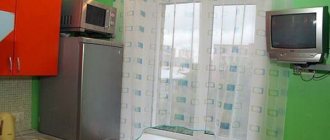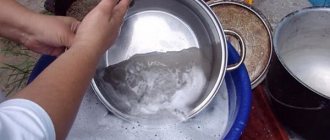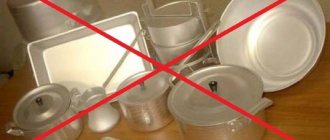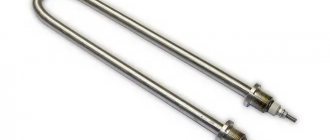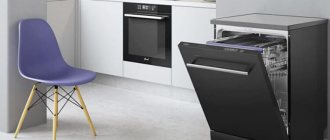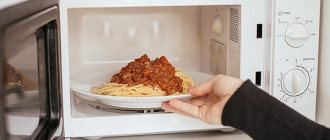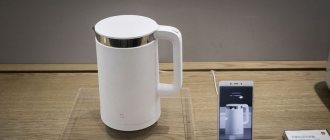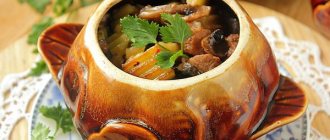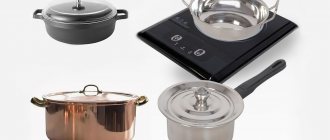Microwave cookware
How to find out which dishes are suitable for the microwave and oven? There is a certain marking - Suitable for Mikroware. This inscription indicates that the cookware is intended for microwave use.
There are dishes without markings, but they seem quite suitable for the microwave. Such utensils need to be tested and found out whether they are suitable for use or not.
- You need to take a container, pour about a glass of water into it and place it in the electrical appliance for one minute at the highest power.
- Next we take it out and check it.
- If the water becomes hot, but the container is not, then such dishes are suitable.
- If the container is warm, you should avoid using such containers.
Glassware
Microwave-safe glassware is perfect. It is of great importance that it is made of special glass. Microwaves pass through it perfectly, which means the food heats up quickly.
You can also control food preparation through the transparent glass. Glassware looks very beautiful and can withstand high temperatures. This cookware does not heat up in an electrical appliance.
It is worth remembering that you should not cook in glass containers with chips, as well as in containers made of thin glass, as they can be damaged in an electrical appliance.
What dishes are suitable for the microwave?
Modern models of microwave ovens allow you not only to quickly heat up a dish, but also to cook it. What dishes can be put in the microwave:
- made of ceramics, without drawings or decoration;
- glass containers;
- polyethylene or cling film;
- silicone containers;
- plastic products;
- linen or cotton napkins;
- Styrofoam cups wrapped in parchment.
Cooking a dish takes longer than heating it, so you should take the choice of container more seriously:
- glass ceramics for microwave oven;
- earthenware, ceramic and porcelain plates and dishes, without decor and lids;
- heat-resistant glass.
An incorrectly selected container can ruin both the prepared food and lead to equipment failure. Let's take a closer look at the compatibility of different types of cookware and microwaves.
What dishes can be used in the microwave oven.
Glass products
It is practical to use transparent plates made of heat-resistant glass as a heating container. They should not have chips or cracks, and also be without any finishing or decoration.
Silicone molds
Silicone molds are most often used for baking muffins. The material is heat-resistant, it is allowed to be used in a microwave oven.
Food grade plastic
Plastic microwave dishes can be used both for heating and for further storage of food. Before purchasing or first use, you should pay attention to the labeling. The terms “Thermoplastic” and “Duroplast” indicate that heating such a container is safe.
Do not heat polystyrene and polyvinyl chloride plastic and polyethylene products.
Products made of porcelain, earthenware, ceramics and glass ceramics
Microwave glass.
Ceramics are great for microwave ovens. In it, food is heated, defrosted, and dishes are prepared, achieving browning. However, do not forget that this material does not tolerate sudden temperature changes.
Fine china and pots or plates with trim are not recommended for use in the microwave. Glass-ceramic containers are resistant to elevated temperatures, therefore it is not forbidden to use them for heating food.
Clay products
Clay products are fired during manufacture, so heating in a microwave oven is not dangerous for them. The basic rule for using clay kitchen items is to avoid sudden temperature changes, otherwise the product will be damaged.
Paper containers
Cardboard cups and wax-coated products are suitable for heating in microwave mode with a power of no more than 800 W. Such containers are for one-time use only.
Parchment paper
Parchment paper is usually used to protect the walls of the microwave oven from greasy splashes when heating food. It is used to cover containers or completely wrap foods for heating.
Silicone dishes
Can silicone dishes be used in the microwave?
- Of course you can, because this cookware is very strong and can withstand temperatures up to 280 degrees.
- Silicone cookware is very popular. It is elastic and this is its big plus.
- Also, nothing sticks to it or burns due to its smooth surface.
- It is a pleasure to use such dishes in everyday life, and food is heated in it perfectly.
Plastic dishes
Plastic utensils are safe to use in the microwave. But such dishes must have the necessary markings. Plastic dishes are great for heating. It is not recommended to cook full meals in such dishes.
With constant exposure to microwaves, plastic has the ability to deteriorate, and it also releases harmful substances. Plastic utensils are much cheaper than other utensils, but their service life is much shorter.
Rules for using microwave oven utensils
Although microwave cooking is simple and safe, anything can happen. Microwaves do not tolerate certain foods, such as chicken eggs, or materials such as metal or foil. Most often, the cause of breakdown is the choice of low-quality cookware. Our editors remind you of some rules for using microwave ovens:
- First of all, avoid dishes with a glass base, with pictures or metal edges. These components can damage the device.
- Only use dry containers.
- Place dishes so that they are directly in the center of the microwave.
- To ensure the internal cleanliness of the device, it is better to use closed containers.
NOTE!
To check whether a dish is suitable for a microwave oven, place a container of water inside it. After heating, check the temperature of the dish, if it is hot, it means it cannot be used in a microwave oven. Heating in foil in the microwave is unacceptable, so do not practice such cooking.
Paper, polyethylene, cling film
Most processed foods are sold in paper packages, but this does not prevent you from heating food in them.
- This is very convenient, especially if the microwave heats your dishes.
- You can only cook in cardboard boxes that are marked.
- Cling film and polyethylene cannot be used in microwaves because they emit hazardous substances.
What dishes should not be used?
If you use the wrong utensils, your microwave oven may break down. The following utensils should never be used:
- Metal utensils in the microwave can cause electrical shock. This will damage the microwave. Also, dishes with an iron rim will not work either. There are special thin aluminum plates, they are marked and can be used in microwaves;
- With a shiny rim or pattern. Almost everyone has plates with shiny rims and designs. Sparks may be seen when using this cookware in the microwave. They are formed due to an electrical discharge, which can damage the microwave. All this is due to the fact that the paint used to paint the pattern contains metal;
- Crystal. Crystal contains silver and lead, so such dishes are not suitable for the microwave. Food will not heat up in this pan. The crystal itself, on the contrary, heats up quite quickly and this can lead to its damage, it will simply fall into pieces right in the microwave;
- It is better not to use wooden utensils in the microwave. It does not harm food, but the dishes themselves can deteriorate, dry out and crack. You can heat food in a wooden plate, but only once, then the dishes will not get damaged.
What dishes are ideal for use in the microwave?
Heat-resistant glassware, ceramic and porcelain utensils, and specially designed containers are most suitable for microwave use. In this section, we will consider options for shapes and containers that are suitable for use in microwaves.
Heat-resistant container for microwave ovens: reliable and safe
Heat-resistant containers used to heat food in the microwave must have a lid with holes. Plastic molds and trays with lids can only be used for microwave ovens if they are made from a material that is resistant to combustion and melting. In addition, such utensils should not have roughness, scratches, or an unpleasant odor.
Microwave glass and ceramic dishes stay cold
It is not advisable to use rectangular glass baking trays for microwaves - food is heated unevenly in them. Microwave glassware should have uniformly thick walls on all sides. At the same time, it is undesirable for such dishes to be decorated with additional patterns and covered with paint. The ideal option is a thick, transparent round utensil. Glassware is universal, as it is suitable for use in the oven and over an open fire. Not a whole plate made of clay, ceramics or porcelain can shatter into pieces in your hands when you remove it from the microwave. Earthenware, porcelain or ceramic dishes are made on the basis of clay; accordingly, they can be used for heating food in the microwave if they have a completely glazed surface. It is also important that the surface of the cookware is made without a border with a metallic color.
NOTE!
Even the slightest chip or crack on ceramic dishes can cause complete destruction of the container right in the microwave.
Microwave dishes made of paper, polyethylene and packaging film
Never heat an empty container in the microwave - this may short out the electrical wiring inside the device. Most likely, in your home use there are containers made of cling film, polyethylene or special heat-resistant paper. This type of packaging is used to sell food in stores, and most of them are suitable for heating in the microwave.
However, before placing such containers in the device, make sure that they have holes for steam to escape. What is it for? First of all, so that the vessel does not explode and stain the insides of the microwave.
Utensil shapes for microwave oven
Not only the quality of the cookware matters, but also the shape and size. It is best to cook in a container with round edges. It heats food evenly.
You can use square and rectangular dishes, but keep in mind that in the corners the food may dry out due to the high concentration of energy.
In wide and shallow dishes, food heats up and cooks faster and better.
In order to prepare some dishes, for example, soup, you need a deep dish that widens towards the top. This is necessary because when boiling, food may splash out, and the expanded edges will save you from this.
- Cylindrical-shaped utensils are great for making muffins and biscuits. But it should be higher than for the oven.
- When heating and cooking food in a microwave oven, it is recommended to use a special lid. This is necessary so that the food does not dry out. The lid also helps speed up the cooking process and makes the food much more tender.
- The lid should be labeled and transparent to allow microwaves to pass through it better. There should be a hole in it for steam to escape. The lid protects against splashes and grease on the walls of the microwave. This way the device will remain clean much longer.
Now it’s clear which dishes can be used in the microwave and which cannot. With the right selection of microwave cookware, it can last for many years. This is good for both technology and food.
Therefore, before you start using cookware in an electrical appliance, you should check the markings and make sure that it is suitable for preparing dishes.
Now you can start preparing various dishes and delight your loved ones.
What does the icon on microwave cookware mean and how to decipher it?
There is a special marking on the dishes that informs the user whether the container can be used in microwave ovens. Please note the variety of notations. Please note the photo of the markings below. This is how plastic utensils are marked, indicating the composition of the product and its suitability for microwave use.
If you see crossed out icons with the image of microwaves, then the container is not suitable for heating food in the microwave. Pay attention to what properties microwave cookware should have.
What dishes should not be put in the microwave: comments from the editorial experts
When choosing dishes for the microwave, consultants will show you options of various volumes and shapes. But these are not so important conditions on which the performance of the microwave and your safety depend.
Metal containers are unsafe
Metal and enamel bowls and cups in a working microwave endanger your health. The presence of iron parts in the cookware, not to mention the base of the container, is extremely dangerous for use. The fact is that microwaves do not pass through iron, but, on the contrary, are reflected from it. Accordingly, this phenomenon causes a microwave error, accompanied by sparking and frequent failure of the device.
Utensils with drawings and ornaments
To avoid testing the microwave's performance, avoid plates with gold-plated edges. Agree, it is not known for certain what dyes were used to create such dishes. It is likely that it also contains elements of some metals, and this, as a result, is not permissible for microwave ovens.
Therefore, in order not to take risks, you should refuse containers with such appearance features.
Luxurious crystal is not for the microwave!
An uneven design of the cookware can cause it to split into small pieces. In the production of crystal tableware, which is often a component of antique sets, silver and lead are used, as well as some other natural metals. In addition, due to the cut surface of the cookware, it may crack under the influence of microwaves.
The real reason: why you shouldn't put metal utensils in the microwave?
If the owner violates the rules for operating a microwave oven, no one will repair the device for free. Almost every second owner of a microwave oven had to deal with the problem of having iron cutlery in a working device. It’s good if everything ended well, but events could have developed even more dangerously.
For example, a breakdown of the device, injury to the owner (electric shock), a short circuit and, as a result, a fire. Metal is not able to pass the waves of a microwave device through itself, but repels them back, thereby destroying the functionality of the electrical device.
Requirements for microwave oven dishes when using combined modes
Using containers for microwave ovens is a very important task, so some requirements must be observed. For detailed information, we offer you a detailed video review, which details the main criteria that cookware for microwave ovens must meet.
